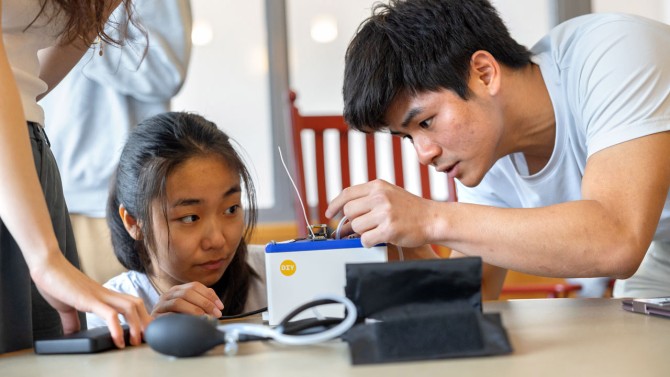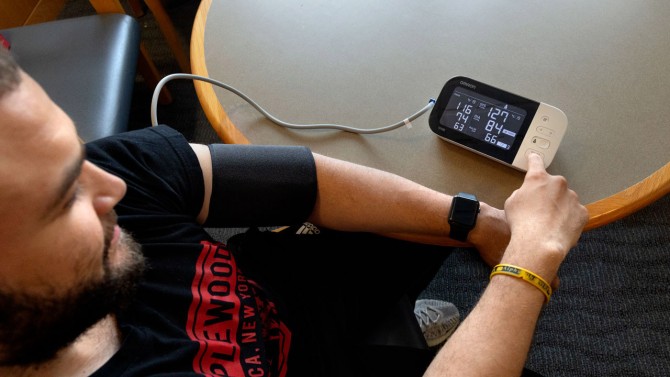
Adrienne Yoon ’25 demonstrates the use of the manual blood pressure cuff and all-in-one device at Cayuga Medical Center.
Students transmit health care data without cell service, internet
By Caitlin Hayes, Cornell Chronicle
The challenge for a group of students in Professor Max Zhang’s Internet of Things course was to take their own data from a blood pressure cuff and send it to Cayuga Health System – without internet or cell service.
The group’s success provides a proof of concept that could enable and improve the in-home care and health monitoring of people in rural and urban settings, including approximately 4,000 residents in Tompkins County. The project is one of seven in Zhang’s course, which pairs student groups with community partners to leverage Internet of Things (IoT) technology, using a form of low-frequency radio, to provide services in areas without cellular or broadband access.
“Every health care system is going to have this population in their service areas that faces this barrier – either they don’t have reliable cellular or broadband access, or they just can’t afford it,” said Zhang, the Irving Porter Church Professor in Cornell Engineering’s Sibley School of Mechanical and Aerospace Engineering and the Kathy Dwyer Marble and Curt Marble Faculty Director at the Cornell Atkinson Center for Sustainability. “They have to travel quite a distance for routine monitoring, which is not good for the patients or the hospitals.”
Three different teams of students have worked with Cayuga Health over the last three spring semesters to determine and address the health provider’s needs, honing in on health care access – in Tompkins County, 13.3% of households do not have a vehicle and 11.6% do not have internet. The groups chose blood pressure monitoring because of the prevalence of hypertension; according to the Centers for Disease Control and Prevention, nearly half of adults nationwide have hypertension, and only one in four of those adults have it under control.
“Our collaboration with Dr. Zhang and his students supports Cayuga Health System’s commitment to removing barriers to health care for community members without reliable transportation or internet access,” said Dr. Marty Stallone, president and CEO of Cayuga Health System. “IoT has the potential to equip patients with the digital health tools they need to become partners in their care and enable our mobile health care workforce to bring high-quality care to rural communities.”
The problem of access is also not only in rural areas – Zhang connected with colleagues at Weill Cornell Medicine who said urban areas have similarly inaccessible populations.
The student group this semester – Sophia Lin ’25, Evan Leong ’25, Steven Sun ’25 and Yunsoo Adrienne Yoon ‘25 – pursued two solutions, using their own blood pressure readings to generate the test data. The first solution relies on a commercial electronic blood pressure cuff already used by Cayuga Health. Students were able to reverse engineer the Bluetooth protocol on the cuff, which was originally set up to send data to an app on a computer or phone.
“The limitation for patients is that you need to access Wi-Fi or cellular to download an app, and then to use the app, you would need to connect every time to sync the data,” said Leong, a computer science major in the Cornell Ann S. Bowers College of Computing and Information Science and Cornell Engineering.
Using resources they found online, students were able to retool the protocol to send the data via Bluetooth to an on-site Raspberry Pi, an inexpensive computer smaller than a deck of cards. The Raspberry Pi then sent data through a Low Power Wide Area Network (LPWAN) that encrypts data and uses low-frequency radio frequencies to transmit that data over long distances. Through LPWAN, the data was sent to Cayuga Health.
The second solution was an all-in-one device that takes and filters data directly from a manual blood pressure cuff, without Bluetooth, and sends it to Cayuga Health via LPWAN.
“We really wanted to test the architecture of the whole system, to prove the feasibility – that you could get blood pressure data off of a cuff one way or another, whether it’s a commercial or manual cuff,” Leong said. “And then validating the network architecture as well, that you can get the data sent wirelessly without the need for Wi-Fi.”
Students said the next group to take up the project will have more work to do in preparing for potential clinical trials and that the project has prompted important questions for Cayuga Health as well, like how to design the system to fulfill privacy requirements.
“I’m really excited for the next group that takes this class to build off of this work,” Leong said. “Our partners were really excited about the progress we made this semester. It’s really promising.”
The impact of the collaboration also extends beyond the project, said Lara Parrilla, community and academic partnership manager for Cayuga Health Partners and co-associate director for the Cornell Center for Health Equity, who helped connect Zhang with Cayuga Health.
“We’ve built a relationship,” she said. “And now, after three years working with Max's students, we’re seeing the federal funding opportunities to test the effectiveness of medical IoT platforms for remote healthcare delivery. This collaboration helps lay a strong foundation for us to pursue innovative research to advance rural health equity.”
Students said the experience of working with a community partner on a real-world problem has been invaluable.
“We used a lot of different disciplines within engineering and applied a lot of fundamentals that I’ll definitely carry with me,” said Lin, an electrical and computer engineering major in Cornell Engineering. “And looking at how to communicate without the internet is equally as cool as the internet itself. Bringing people in rural areas these technologies that they can use every day is really meaningful.”
Zhang’s course, Introduction to the Internet of Things (IoT) – Technology and Engagement, was created with support from the National Science Foundation, Cornell’s David M. Einhorn Center for Community Engagement and Cornell Engineering’s Shen Fund for Social Impact.
Media Contact
Get Cornell news delivered right to your inbox.
Subscribe


